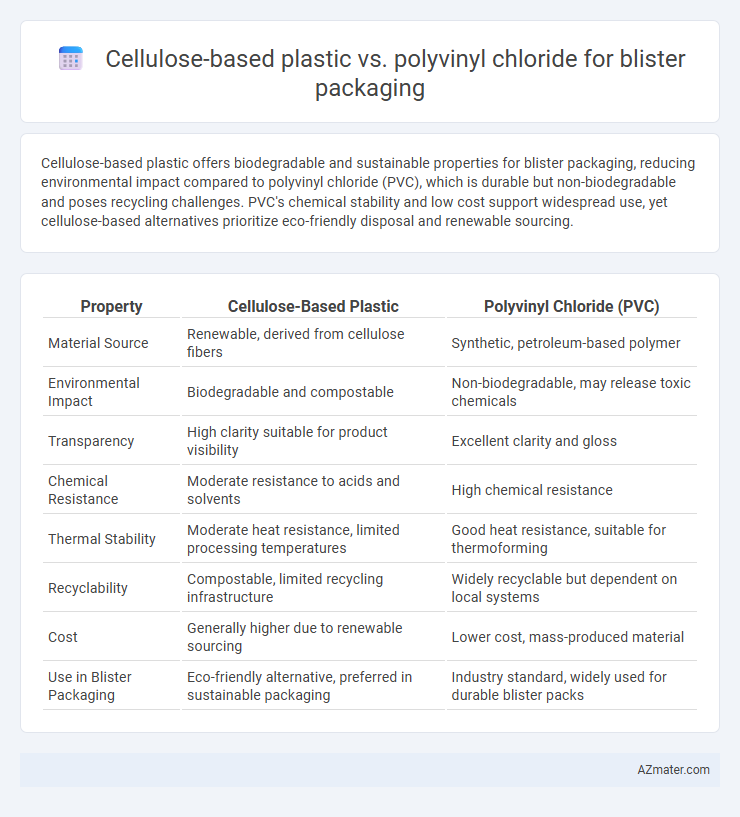Cellulose-based plastic offers biodegradable and sustainable properties for blister packaging, reducing environmental impact compared to polyvinyl chloride (PVC), which is durable but non-biodegradable and poses recycling challenges. PVC's chemical stability and low cost support widespread use, yet cellulose-based alternatives prioritize eco-friendly disposal and renewable sourcing.
Table of Comparison
| Property | Cellulose-Based Plastic | Polyvinyl Chloride (PVC) |
|---|---|---|
| Material Source | Renewable, derived from cellulose fibers | Synthetic, petroleum-based polymer |
| Environmental Impact | Biodegradable and compostable | Non-biodegradable, may release toxic chemicals |
| Transparency | High clarity suitable for product visibility | Excellent clarity and gloss |
| Chemical Resistance | Moderate resistance to acids and solvents | High chemical resistance |
| Thermal Stability | Moderate heat resistance, limited processing temperatures | Good heat resistance, suitable for thermoforming |
| Recyclability | Compostable, limited recycling infrastructure | Widely recyclable but dependent on local systems |
| Cost | Generally higher due to renewable sourcing | Lower cost, mass-produced material |
| Use in Blister Packaging | Eco-friendly alternative, preferred in sustainable packaging | Industry standard, widely used for durable blister packs |
Introduction to Blister Packaging Materials
Blister packaging materials primarily consist of plastics like cellulose-based plastic and polyvinyl chloride (PVC), each offering distinct advantages and environmental impacts. Cellulose-based plastics are biodegradable and derived from renewable resources, making them ideal for sustainable blister packaging solutions. Polyvinyl chloride provides excellent clarity, strength, and barrier properties, commonly used for protecting pharmaceuticals and consumer goods despite concerns about its environmental footprint.
Overview of Cellulose-Based Plastics
Cellulose-based plastics, derived from natural polymers found in plant cell walls, offer a biodegradable and renewable alternative to conventional plastics like polyvinyl chloride (PVC) used in blister packaging. These bioplastics exhibit excellent moisture resistance, transparency, and mechanical strength, making them suitable for protecting pharmaceuticals and consumer goods while reducing environmental impact. Their compostability and lower carbon footprint contribute to sustainable packaging solutions, contrasting with PVC's persistence and potential release of harmful chemicals during disposal.
Understanding Polyvinyl Chloride (PVC) in Packaging
Polyvinyl chloride (PVC) in blister packaging offers excellent clarity, flexibility, and durability, making it a preferred choice for protecting and displaying products. Its excellent barrier properties against moisture and contaminants ensure product freshness and integrity during storage and transport. However, environmental concerns over PVC's non-biodegradability and challenges in recycling have driven the search for more sustainable alternatives like cellulose-based plastics.
Mechanical Properties Comparison: Cellulose-Based vs PVC
Cellulose-based plastics exhibit superior tensile strength and flexibility compared to polyvinyl chloride (PVC) in blister packaging applications, enhancing durability and resistance to deformation under stress. PVC offers excellent impact resistance and clarity but tends to be more brittle and prone to cracking over time, especially under varying temperature conditions. The mechanical robustness of cellulose-based materials supports better eco-friendly packaging solutions while maintaining essential protective qualities for pharmaceutical products.
Barrier Performance: Moisture and Gas Protection
Cellulose-based plastics exhibit superior moisture barrier properties due to their hydrophobic nature, reducing water vapor transmission rates essential for sensitive blister packaging. Polyvinyl chloride (PVC) offers moderate gas barrier performance but tends to allow higher oxygen permeability compared to cellulose derivatives, potentially compromising product shelf life. Optimizing blister packaging requires balancing cellulose's enhanced moisture protection with PVC's structural and sealing advantages for effective barrier performance.
Environmental Impact and Sustainability
Cellulose-based plastics for blister packaging offer significant environmental benefits due to their biodegradability and origin from renewable resources, reducing reliance on fossil fuels and lowering carbon emissions compared to polyvinyl chloride (PVC). PVC, while durable and cost-effective, poses environmental challenges such as persistent plastic pollution, toxic chlorine content, and difficulties in recycling, which contribute to long-term ecological harm. Transitioning to cellulose-based alternatives enhances sustainability by promoting circular economy principles and minimizing hazardous waste generation in packaging applications.
Clarity and Aesthetic Appeal in Packaging
Cellulose-based plastic offers superior clarity and a natural, matte finish that enhances the aesthetic appeal of blister packaging, providing a premium, eco-friendly look. Polyvinyl chloride (PVC) provides excellent transparency and gloss, delivering a sharp, vibrant display but often lacks the sustainable image associated with cellulose materials. The choice between cellulose-based plastic and PVC significantly impacts consumer perception, balancing visual appeal with environmental considerations in blister packaging design.
Regulatory Compliance and Safety Considerations
Cellulose-based plastics for blister packaging offer superior biodegradability and align well with stringent regulatory standards such as REACH and FDA guidelines, minimizing environmental impact and potential toxicological risks. Polyvinyl chloride (PVC), while cost-effective and widely used, faces scrutiny under regulations due to concerns about phthalates and dioxin release during manufacturing and disposal, posing challenges for long-term safety compliance. Choosing cellulose-based alternatives enhances compliance with evolving global safety regulations and supports sustainable packaging initiatives without compromising performance.
Cost Analysis: Production and Lifecycle Costs
Cellulose-based plastic for blister packaging typically incurs higher initial production costs due to raw material extraction and processing complexities compared to polyvinyl chloride (PVC), which benefits from established manufacturing infrastructure and lower material expenses. Lifecycle costs favor cellulose-based plastics through enhanced biodegradability and reduced environmental remediation expenses, while PVC involves higher disposal costs linked to its persistence and toxic byproducts during incineration. An in-depth cost analysis reveals that long-term economic benefits of cellulose-based alternatives can offset upfront investments, especially when factoring in regulatory compliance and sustainability-driven market demands.
Future Trends and Market Adoption
Cellulose-based plastics for blister packaging are gaining traction due to their biodegradability and alignment with sustainability goals, appealing to eco-conscious consumers and regulatory bodies. Polyvinyl chloride (PVC) remains widely used due to its durability, transparency, and cost-effectiveness, but faces increasing scrutiny because of environmental concerns and tightening regulations on plastic waste. Market adoption trends indicate a gradual shift towards cellulose-based alternatives as manufacturers seek to reduce carbon footprints and comply with evolving environmental standards, supported by advancements in bioplastic technology enhancing performance and scalability.

Infographic: Cellulose-based plastic vs Polyvinyl chloride for Blister packaging
 azmater.com
azmater.com